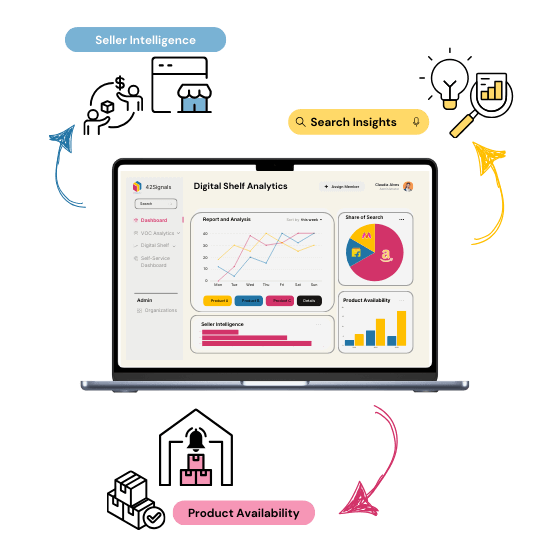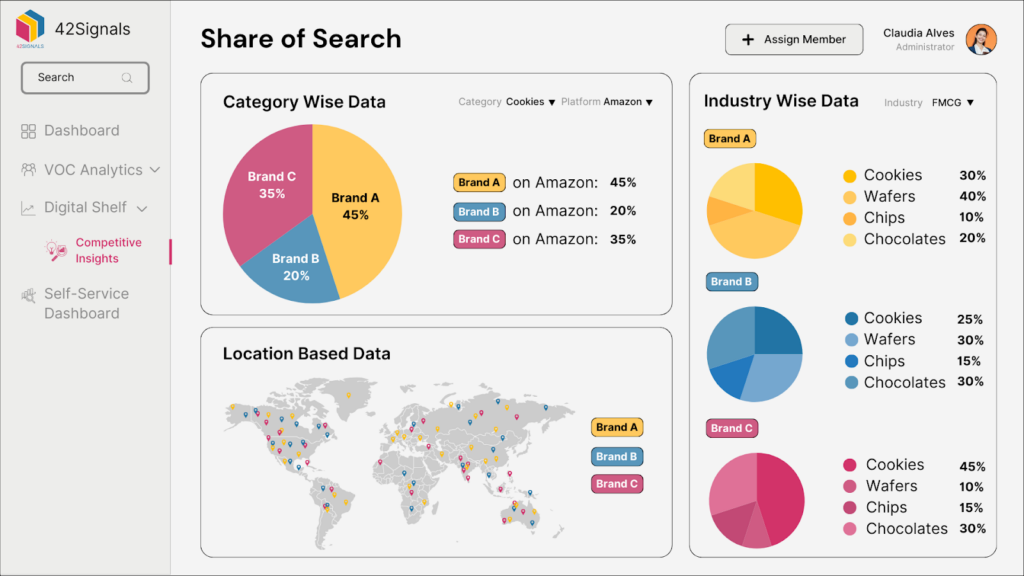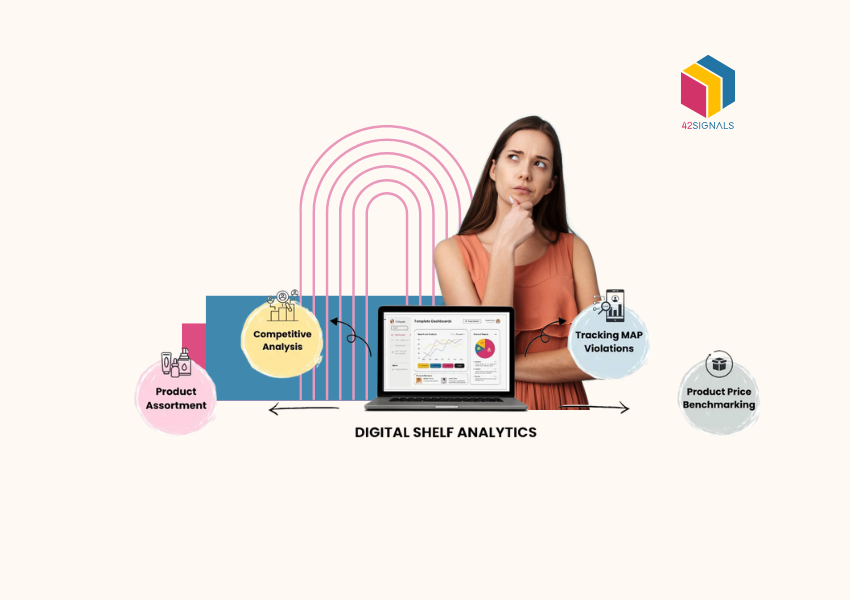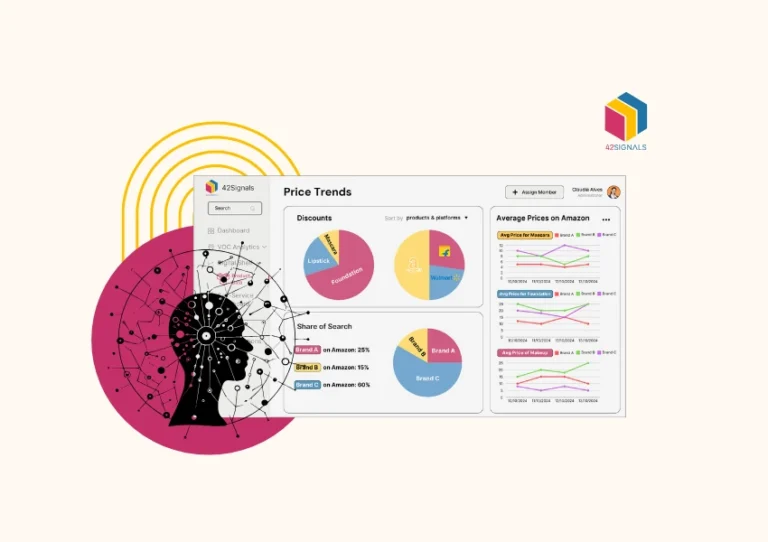Brands operating today are battling it online and offline for visibility. Once this batter is won, they need to focus on winning customer loyalty. If a customer searches for, let’s say, Brand Unicart’s products online and finds outdated images or another seller/website selling the same item at a fraction of the cost, it can lead to damaging reputation and revenue. That’s why digital shelf monitoring is so important.
It helps brands serious about ecommerce success ensure accurate product data and prices on online marketplaces to catch any MAP violations.
What is Digital Shelf Monitoring?

The “digital shelf” refers to how your products appear across online channels—your website, Amazon, Walmart, social media, or any platform where customers discover and purchase your items. And, digital shelf monitoring involves tracking every element of your product’s online presence:
- Product data (descriptions, images, specs)
- Pricing (including MAP violations)
- Product Availability (stock levels, delivery times)
- Visibility (search rankings, share of search)
- Competitor activity (price changes, promotions)
It audits all platforms and data points to identify any anomalies. Without it, keeping tabs on your products and competitors would be next to impossible.
Why Digital Shelf Monitoring Can’t Be Ignored?
1. Product Data Accuracy Drives Conversions
Inconsistent or incomplete product data is a silent conversion killer. If your title says “wireless headphones” on your site but “Bluetooth earphones” on Amazon, customers may not realize it’s the same product. Worse, conflicting specs or outdated images create distrust.
Digital shelf analytics tools scan every platform to ensure your product data is uniform and optimized.

For example, a skincare brand using these tools noticed a 30% drop in sales for a moisturizer at Walmart. The culprit? An old product image showing discontinued packaging. Fixing this restored sales within days.
2. Share of Search Determines Market Share
“Share of search” measures how often your products appear in search results compared to competitors. If your items aren’t ranking for key terms, you’re invisible to shoppers. Digital shelf monitoring tracks this metric in real time, revealing gaps in SEO, content, or pricing strategies.

A kitchenware brand, for instance, discovered their pots and pans ranked on page 3 for “non-stick cookware” despite heavy ad spending. By analyzing competitor listings, they revamped product titles with high-volume keywords, boosting organic traffic by 65%.
3. MAP Violations Erode Profit Margins
Minimum Advertised Pricing (MAP) violations can be detrimental to brands, especially when they occur often by multiple sellers. They devalue brands, undercut revenue, and, if your brand is still relatively new, may even come off as scammy.
With digital shelf analytics, brands can instantly flag MAP violations. One electronics manufacturer identified a third-party seller on eBay listing their headphones 40% below MAP. By enforcing their policy, they shut down the seller and reclaimed control over pricing.
4. Pricing Analytics Keep You Competitive (and Profitable)
Pricing isn’t static. A competitor’s flash sale or marketplace algorithm change can tank your sales overnight. Digital shelf monitoring tools provide granular pricing analytics, showing:
- How do your prices compare to competitors in real time
- Demand fluctuations during holidays or sales events
- Regions where discounts could boost conversions without hurting margins
A toy company used this data to adjust prices dynamically during Black Friday, avoiding a race to the bottom while still staying competitive.
5. Competitor Analysis Uncovers Hidden Opportunities

- What’s your competitor’s best-selling product?
- How often do they discount?
- What keywords are they targeting?
Digital shelf reviewing answers these questions, turning competitors’ strategies into your playbook.
When a fitness apparel brand noticed a rival’s sudden spike in sales for “yoga leggings,” they analyzed the competitor’s product pages. The discovery? User-generated content in image galleries boosted trust. The brand quickly added customer photos to their listings, lifting conversions by 22%.
How to Build a Digital Shelf Monitoring Strategy?

Image Source: Gepard
Step 1: Audit Your Current Digital Shelf Health
Use tools like 42Signals to scan all platforms for:
- Inaccurate or missing product data
- MAP violations and unauthorized sellers
- Poor search rankings or low share of search
- Competitor pricing and promotion trends
These information points can strengthen understanding of what’s working and what needs to be improved. It can also highlight what competitors are doing better than your brand.
Step 2: Standardize Product Data Across Channels
Create a unified product information template for all retailers, including:
- High-resolution images and videos
- Consistent titles, descriptions, and keywords
- Up-to-date specs and compliance badges
Having standardized descriptions and images across marketplaces projects a unified and strong brand. It means a consumer shopping on any part of the internet will have the same information and if they choose a different source, will not see different messaging/imagery.
Step 3: Automate Monitoring and Alerts
Set up real-time alerts for:
- Price changes (yours and competitors’)
- Stockouts or listing removals
- New unauthorized sellers or MAP violations
Another crucial step is understanding what’s changing and, more importantly, when. This data and timely alerts from a platform like 42Signals can nip issues in the bud.
Step 4: Act Fast on Insights
- Negotiate with retailers to fix pricing errors.
- Report and remove counterfeit listings.
- Adjust SEO or content based on share of search gaps.
When all the data is understood and properly categorized, take prompt action to rectify the issues before they fester.
The Cost of Ignoring Your Digital Shelf
Brands that neglect digital shelf monitoring risk:
- Lost Revenue: 89% of shoppers won’t buy from a site with inaccurate product info.
- Damaged Reputation: MAP violations and counterfeit sellers erode consumer trust.
- Missed Trends: Competitors capitalize on pricing or SEO opportunities you overlook.
These problems tend to have a snowball effect, getting bigger and harder to deal with as time passes by. Prompt addressal and constant monitoring of issues are absolutely essential.
Conclusion
In ecommerce, your digital shelf isn’t just a sales channel—it’s the frontline of your brand’s survival. From safeguarding pricing integrity with MAP enforcement to optimizing product data for search, every detail matters.
Tools like 42Signals offer actionable insights to protect your revenue, outmaneuver competitors, and deliver seamless shopping experiences. The question isn’t whether you can afford to invest in digital shelf monitoring—it’s whether you can afford not to.
Ready to Take Control of Your Digital Shelf? Schedule a demo with 42Signals today to see how real-time analytics can transform your ecommerce strategy.





